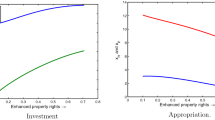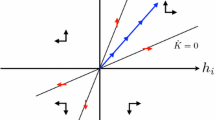Abstract
The paper argues that it is useful to view property regimes asinformation regimes. A conceptual model and numerical example are usedto show that, under some reasonable assumptions, a common propertyregime is preferable to a private property regime when property regimesare viewed as information regimes. The paper considers a case ofidiosyncratic risk in a dynamic grazing context where the marginality ofthe resource is such that insurance markets are thin or non-existent.Agents are thought to be risk averse and exogenous enforcement of a risksharing scheme is not feasible. The policy implication is that theestablishment and maintenance of a common property regime is shown to bea (possibly) reasonable institutional response in the face of difficultand particular circumstances when property regimes are viewed asinformation regimes.
Similar content being viewed by others
REFERENCES
Bowles, S. and H. Gintis (1996), ‘Homo Reciprocans: Egalitarian Values andRedistributive Policy’, mimeo, University of Massachusetts.
Bromley, D. W. and M. Cernea (1989),‘The Management of Common Property Natural Resources’, World Bank Discussion Papers 57.
Bromley, D. W. (1991), Environment and Economy: Property Rights and Public Policy, Cambridge,MA: Basil Blackwell.
Coate, S. and M. Ravallion (1993), ‘Reciprocity without commitment’, Journalof Development Economics 40, 1–24.
Conrad, J. M. (1995), ‘Bioeconomic models of the fishery’, inD. Bromley, ed., The Handbook of Environmental Economics, Cambridge: Basil Blackwell.
Dasgupta, P. (1993), An Inquiry into Well-Being and Destitution, Oxford: Oxford University Press.
Demsetz, H. (1967), ‘Towards a Theory of Property Rights’, American Economic Review 57, 347–359.
Gravelle, H. and R. Rees (1992), Microeconomics, 2nd ed, London: Longman.
Hardin, G. (1968), ‘The Tragedy of the Commons’, Science 162, 1243–1248.
Kreps, D. M.(1990), A Course in Microeconomic Theory, London: Harvester Wheatsheaf.
Netting, R. (1976), ‘WhatAlpine Peasants Have in Common: Observations on Communal Tenure in a Swiss Village’, Human Ecology 4, 135–146.
Ostrom, E. (1990), Governing the Commons: the Evolution of Institutions for CollectiveAction, Cambridge: Cambridge University Press.
Park, T. K. (1993), Risk and Tenure in Arid Lands,Tuscon: University of Arizona Press.
Runge, C. F. (1992), ‘Oukaimedend, Morocco: A High MountainAgdal’, in D. Bromely and D. Feeny, eds., Making the Commons Work, San Francisco: ICS Press.
Sargent, T. J. (1987), Macroeconomic Theory, San Diego: Academic Press.
Thompson, G. D. andN. Wilson (1994), ‘Common Property as an Institutional Response to Environmental Variability’, Contemporary Economic Policy 12, 10–12.
van den Brink, R., D.W. Bromley, and J. P. Chavas(1995), ‘The Economics of Cain and Able: Agro-Pastoral Property Rights in the Sahel’, The Economics of Cain and Able: Agro-Pastoral Property Rights in the Sahel 31, 373–399.
Author information
Authors and Affiliations
Rights and permissions
About this article
Cite this article
Steele, S.R. Property Regimes as Information Regimes: Efficiency and Economies of Joint Production. Environmental and Resource Economics 18, 317–337 (2001). https://doi.org/10.1023/A:1011109326298
Issue Date:
DOI: https://doi.org/10.1023/A:1011109326298




